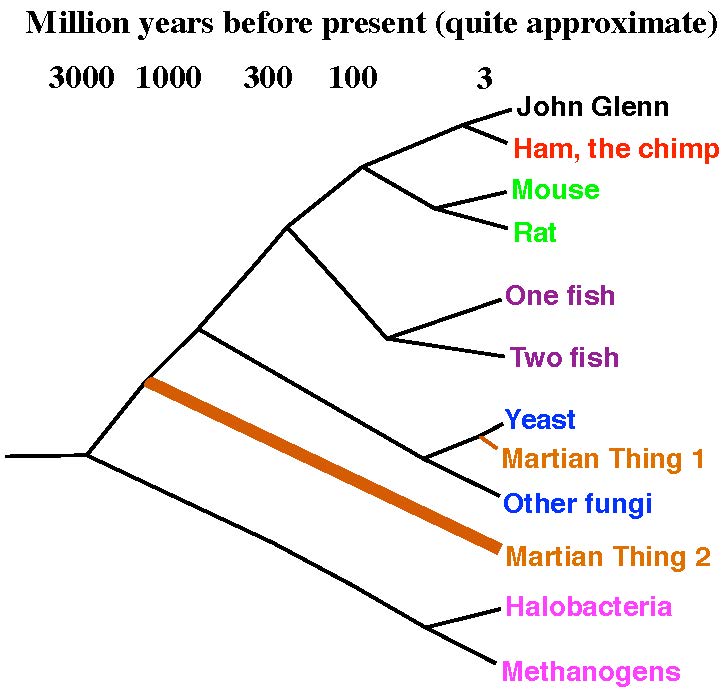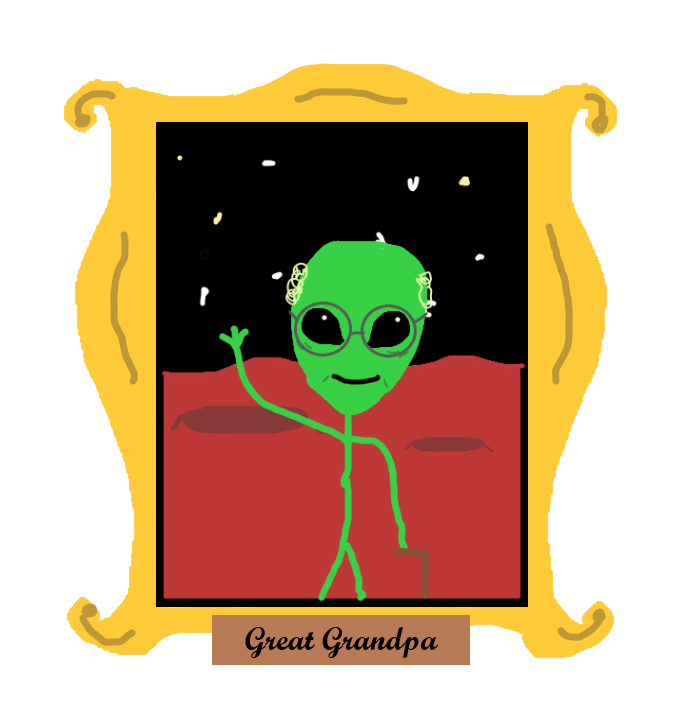Cite as: Benner, Steven A. “If we are related to Martians, how would we know (Part 1)?”. Primordial Scoop. 3/29/2021. https://doi.org/10.52400/ZQLO5938.
As Homo sapiens, we have evolved the ability to identify members of our tribe: people who share our DNA polymorphisms. This has a Darwinian purpose, “kinship selection”.
This ability extends to relationships between species. For example, Ham, the first American Pan troglodytes (a.k.a. chimpanzee) in space, and John Glenn, the first American Homo sapiens orbiter in space, resemble each other, at least to the human eye. And yes, they are closely related. John and Ham share ancestors that lived about 5 million years ago.

Biologists systematize this kind of analysis by choosing “characters” that (they hope) best group species into families with the most recent common ancestry. For example, biologists tell us that “suckling young” is a better character for classifying animals than, for example, “swimming in oceans”. As fans of Star Trek: The Voyage Home know, whales, who suckle their young, are more closely related to Homo sapiens than fish, who do not. Even though fish and whales both have fins that let them efficiently swim in oceans.
And that makes a point: shared characters (like fins) need not indicate ancestry if they are specially adapted to a particular lifestyle. This phenomenon, where distantly related animals independently evolve very similar characters, is called convergent evolution by evolutionary biologists. If you are a mammal who decides to go swim in the ocean, of course you will evolve fins and flippers. The features that best reflect your historical ancestry (like legs and lungs) are those that are not adaptive.
This is why biologist were delighted when gene sequencing came along. A typical protein is 300-500 amino acid “letters” long. Each of these is a character that has one of 20 values because there are 20 different kinds of amino acids. Further, most amino acids can be replaced over time without destroying the adaptive function of the protein. And so as time goes by, the sequences diverge. The more time that passes, the more divergence occurs.
Here is an example. Astronaut Ham, the chimpanzee, synthesizes cholesterol and related compounds known as “terpenes” using an enzyme that condenses acetyl CoA with acetoacetyl CoA. We will have reason to analyze the “coenzyme A” (CoA) in this reaction and the mechanism of the reaction in the next Single Scoop.

Now, both Ham and John need cholesterol and terpenes to live. So the fact that both Ham and John have a protein that makes these need not indicate that they are related. The metabolic path to make cholesterol and terpenes could have arisen convergently in unrelated chimps and humans.
But look a part of the sequence of amino acids in the human (black) and chimp (red) proteins that catalyze this condensation. Each protein is a book written in the letters of the protein language, 300-500 of them typically. Ham’s protein and John’s protein are identical. In the 5 million years since Ham and John diverged, not a single amino acid “letter” in the protein “book” has been replaced.

Now, Mickey (the mouse) diverged from primates (Ham and John) about 100 million years earlier. Their proteins actually do differ, 2 letters out of the fifty shown; they are only 96% identical. The sequence in the fish (violet) differs more, in 5 of the 50 amino acids. The line of descent leading to fish diverged from the line leading to primates ~ 400 million years ago. The sequence of the homologous protein in yeast has 13 amino acid differences; it is only 76% identical. The lineage leading to yeast diverged perhaps a billion years ago,
Remarkable. The yeast making your wine, the guppy in your goldfish bowl, the mouse in Disney World, Ham the chimp, and John the astronaut, all have a protein related by common ancestry. And many other proteins in addition.
More remarkably, judging only by percent sequence identity, the species are ranked in exactly the same way as they are ranked in classical biology. Human and chimps are more closely related to each other than either are to a mouse. The mammals who suckle their young are more closely related to each other than any are to fish 1 or fish 2. The animals are more closely related to each other than any are to yeast. Last, the species having cells with nuclei are more closely related to all other eukaryotes than any is to the archaebacterium that lives in the Dead Sea.
That relationship is described by a family tree. Here it is, with approximate dates.

Flash forward to our discovery of life on Mars. How could we decide whether or not Martian life shares a common ancestor with Ham, John, you and me?
If the Martian makes terpenes, that is a positive sign. But remember, maybe terpene molecules with branched carbon chains are universally required to “do” biology. If so, even entirely independent life on Mars would have converged to make terpenes.
And so we would look at the molecular biology of the Martian to see first whether Martians make terpenes by the same path as Earthlings. And if they do, we would ask if Martians had a protein that catalyzed the reaction with Acetyl-CoA. And if they do, we would determine the sequence of that protein. And place that sequence on the family tree.

A couple of possibilities. For example, a protein from Martian Thing 1 might have a sequence that fits on the tree right next to the yeast sequence. If so, we might worry that Martian Thing 1 was in fact an Earthling fungus that had flown with the spacecraft to Mars. We would call the Planetary Protection Officer.
However, a protein from Martian Thing 2 might have a sequence that branches deep in the tree, perhaps 2000 million years (that is, two billion) ago. We might still worry about hitchhikers using our lander to guide themselves through the galaxy. But it would imply that:
- No halobacteria, methanogens, or other archaebacteria are to be found on Mars.
- That life came from Earth to Mars, not the other way around.
- Life arrived from Earth to Mars two billion years ago.
A lot of information from one lousy protein sequence. Which is why we must go find it.
But those who follow this blog know that we are unlikely to stop here. We must think out of the box. What if Martians make terpenes but … do not have any proteins at all?
For that, we must wait until Part 2.




Pingback: If we are related to Martians, how would we know (Part 2)? – The Primordial Scoop